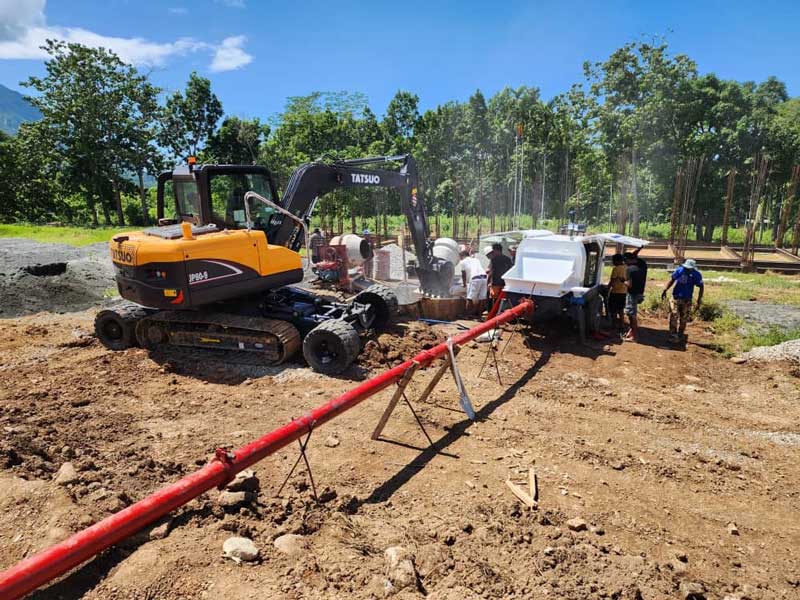For construction companies in Latin America, purchasing a concrete pump involves more than just selecting a model—it means navigating a complex cost structure. While the base concrete pump price is a major factor, it’s far from the only one. In this region, external forces like volatile steel prices and country-specific tax policies can significantly affect the final cost of ownership. Understanding these variables is crucial for businesses looking to optimize their investment in concrete equipment.
Why Steel Prices Matter in Concrete Pump Manufacturing
Steel is the backbone of every concrete pump, whether it’s a heavy-duty trailer concrete pump or a compact mini concrete pump. The boom arm, hydraulic components, frame, and even piping systems rely on high-quality steel for strength and durability. As such, global steel market trends have a direct influence on manufacturing costs.
Global Steel Price Volatility
In recent years, steel prices have experienced major fluctuations due to supply chain disruptions, geopolitical tensions, and shifting demand from sectors like automotive and energy. For Latin American buyers, this often translates into noticeable price swings in imported machinery or locally assembled units with imported steel components.
For example, when steel prices rose sharply in 2021 and 2022, concrete pump manufacturers were forced to increase prices across their entire product range. In markets like Brazil, Chile, and Colombia, the concrete pump price(bomba de hormigón precio) rose by as much as 10–20%, even without any changes to design or features.
Impact on Different Pump Types
The impact of steel prices is more pronounced in large, high-capacity machines like trailer concrete pumps, which use more material. On the other hand, a mini concrete pump, with its compact structure, may experience a relatively smaller price increase. However, no model is immune. Increases in raw material costs ultimately trickle down to the customer, regardless of pump size.

How Local Taxes Shape the Final Purchase Price
Each Latin American country applies its own combination of import duties, VAT, and industry-specific taxes. These fiscal policies can significantly inflate the price of imported concrete pumps(bomba de concreto)—especially those manufactured in Europe, China, or the U.S.
Import Tariffs and Duties
Many Latin American countries apply import tariffs ranging from 5% to 25% on construction equipment. For instance:
- Mexico has lower tariffs due to free trade agreements but applies strict customs documentation requirements.
- Brazil imposes both import tax (II) and industrialized product tax (IPI), which together can increase the concrete pump price by over 30%.
- Argentina’s high import duties and complex exchange rate rules make imported machinery significantly more expensive.
Value-Added Tax (VAT)
In addition to tariffs, most countries charge VAT (known as IVA in Spanish-speaking countries) on machinery sales. Rates vary from 13% in Paraguay to 19% in Chile. This VAT is often non-refundable on capital equipment for small or mid-sized contractors, making the actual cost higher than the listed retail price.
Local Compliance Costs
Some countries require equipment certification or registration with local authorities, which can add extra cost and delay delivery. Furthermore, service availability, spare parts localization, and warranty validation may require partnerships with local agents, increasing the total investment further.

Real-World Impact on Procurement Decisions
Price Gaps Between Markets
Two identical trailer concrete pumps(bomba estacionaria de hormigón) might sell at very different prices in neighboring countries due to tax and tariff differences. For instance, a pump that costs $50,000 in Peru could cost over $60,000 in Bolivia once import duties and VAT are applied. Contractors must plan budgets accordingly, often factoring in cross-border procurement strategies or negotiating local assembly agreements to save costs.
Shift Toward Smaller, Localized Solutions
To counter rising import costs, many contractors in Latin America are turning to smaller, more affordable solutions like the mini concrete pump. These machines are easier to transport, require less fuel, and may fall under lower customs thresholds due to their compact size. As a result, they’ve become increasingly popular for urban construction and residential projects where a trailer concrete pump might be overkill.
Supplier Flexibility and Financing
Suppliers that understand regional complexities often offer flexible solutions—such as delayed delivery, localized support, or financing options to offset high upfront tax burdens. Some manufacturers even collaborate with local partners to assemble equipment regionally, reducing dutiable value and accelerating delivery.
How to Make Smarter Buying Decisions
For construction businesses across Latin America, there are several strategies to minimize the total cost of acquiring a concrete pump:
- Compare offers from multiple suppliers and ask for cost breakdowns that include tax and shipping.
- Check if local assembly options exist to reduce import costs.
- Consider smaller models like a mini concrete pump(mini bomba de concreto) if project scope allows.
- Evaluate long-term operating costs alongside the upfront concrete pump price.
- Ensure suppliers can provide local service and parts to avoid expensive downtime.
Conclusion: Price Is Just the Tip of the Iceberg
In Latin America, purchasing a concrete pump involves navigating not just technical requirements, but also financial and regulatory complexities. While the base price is important, external factors like global steel trends and local tax structures play a major role in shaping the final cost. Whether you’re investing in a high-capacity trailer concrete pump or a versatile mini concrete pump, understanding these elements is key to making a smart, sustainable investment.
By factoring in these hidden costs early in the decision-making process, contractors can avoid budget overruns, reduce risk, and ensure smoother project execution—even in one of the most price-sensitive and logistically complex regions in the world.
